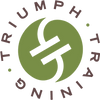Push Pattern
In reality, muscles do not push. Movements, even pushing ones, occur because a muscle (or muscles) contracts or shortens and pulls the origin and insertion closer together. Even during a push up, the triceps contract to pull the origin and insertion closer together, causing the arms to extend and the body to rise away from the ground. This, of course, is achieved with the help of additional actions of the pectorals and deltoids (not to mention countless core muscles essential to a proper push up. These are the same muscles often lacking in a guy who has a 250-pound bench, yet can’t hold his pelvis level to perform a decent push up). In the sport of triathlon, forward propulsion is achieved mainly by the action of these muscles. This section will focus exclusively on the upper-body pushing movements.
NOTE: Anytime you do unilateral (i.e. single arm) Pull or Push Patterns, you are creating a rotational force and, thus, mobilizing the spine. This not only helps nourish the spine by pumping the spinal discs with the fluids essential for health, it’s also specific to the movement patterns involved in triathlon.
First Descent—Braced
Second Descent—Seated or lying
Third Descent—Seated or lying on fixed-axis machine
EXAMPLE EXERCISES
Push Ups
1. In prone position with arms outstretched and hands placed shoulder width apart, lower the body down until the upper arm is approximately parallel with the floor.
2. Return to start position and repeat.
Decline Push Ups
1. In prone position with arms outstretched, hands placed shoulder width apart, and feet on an elevated surface, lower the body down until the upper arm is approximately parallel with the floor.
2. Return to start position and repeat.
Medicine-Ball Push Ups
1. In prone position with arms outstretched and hands placed on a medicine ball, lower the body down until the upper arm is approximately parallel with the floor.
2. Return to start position and repeat.
Bosu Push Ups
1. In prone position with arms outstretched and hands placed shoulder width apart on a Bosu, lower the body down until the upper arm is approximately parallel with the floor.
2. Return to start position and repeat.
Hands-on-Physio-Ball Push Ups
1. In prone position with arms outstretched and hands placed shoulder width apart on a physio ball, lower the body down until the chest just touches the ball.
2. Return to start position and repeat.
Feet-on-Physio-Ball Push Ups
1. In prone position with arms outstretched, hands placed shoulder width apart, and feet (or foot to increase neurological complexity) on a physio ball, lower the body down until the upper arm is approximately parallel with the floor.
2. Return to start position and repeat.
Shoulder Press
1. Standing with Good Posture, hands holding two dumbbells just above the shoulders with palms facing forward, extend arms overhead.
2. Return to start position and repeat.
Arnie Press
1. Standing with Good Posture, hands holding two dumbbells at shoulder height with palms facing body, extend arms overhead so that palms end the movement facing forward.
2. Return to start position and repeat.
Unilateral Arnie Press
1. Standing with Good Posture on the dominant leg, hands holding two dumbbells at shoulder height with palms facing body, extend non-dominant arm overhead so that the palm ends the movement facing forward.
2. Return to start position and repeat with the opposite arm, switching stance legs once half the reps in the set are completed.
Bosu Arnie Press
1. Standing with Good Posture on a Bosu, hands holding two dumbbells at shoulder height with palms facing body, extend arms overhead so that palms end the movement facing forward.
2. Return to start position and repeat.
Kneeling-on-Physio-Ball Arnie Press
1. Kneeling with Good Posture on a physio ball, hands holding two dumbbells at shoulder height with palms facing body, extend arms overhead so that palms end the movement facing forward.
2. Return to start position and repeat.
Straight-Arm Push Downs
1. Stand with Good Posture, hands holding a bar with a pronated grip, swim width apart.
2. Push down and bring hands toward the legs until bar touches thighs. Do not allow arms to bend at elbows as pivot point is at the shoulders.
3. Return to start position and repeat.
Unilateral Straight-Arm Push Downs
1. Stand with Good Posture, non-dominant hand holding a handle with a pronated grip.
2. Push down and bring hand toward the legs until it is beside or even behind the thigh. Do not allow arm to bend at elbow as pivot point is at the shoulder.
3. Return to start position and repeat.
Cable Push
1. Stand in a counter stance with Good Posture while holding a handle at shoulder level with the non-dominant hand and a pronated grip. The arm should be pulled back so the elbow is high and the forearm parallel to the angle of the dominant arm which should be outstretched in front of the body, palm down.
2. Push non-dominant hand away from the body while simultaneously rotating along the axis of the spine to the dominant side. Hands should switch places so that the dominant hand is now at shoulder level with a high elbow and the other arm is outstretched in front of the body with the palm facing down.
3. Return to start position and continue for the designated number of reps before repeating on the opposite side.
Swim
1. Stand facing a cable machine with non-dominant side holding a dumbbell at shoulder height with palm facing body and the dominant side holding a handle at shoulder height with palm facing forward and the elbow glued to the side of the body.
2. Simultaneously extend the non-dominant side overhead while pressing the handle down until the dominant arm is fully extended.
3. Return to start position and continue for the designated number of reps before repeating on the opposite side(s).

Leave a comment
Please note, comments must be approved before they are published